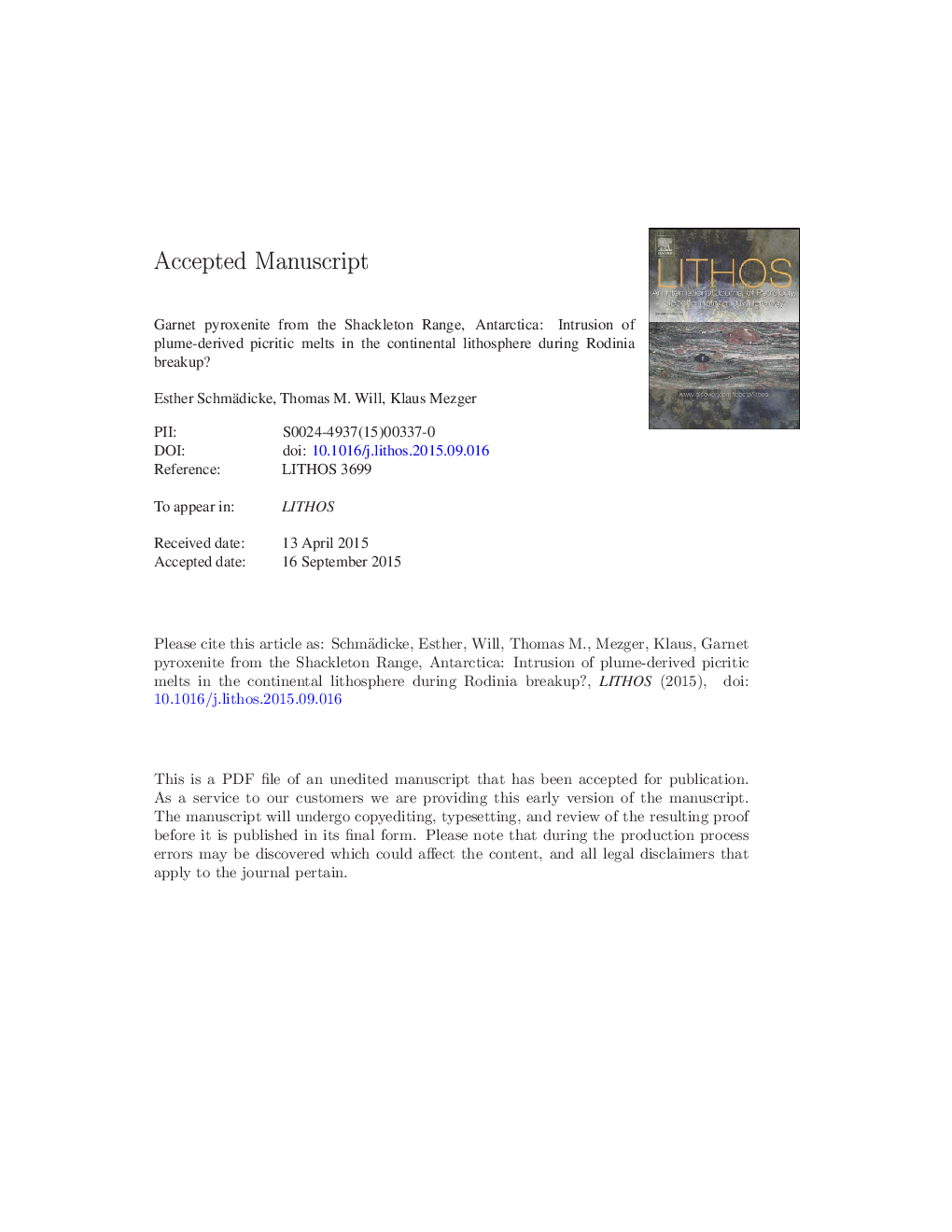| کد مقاله | کد نشریه | سال انتشار | مقاله انگلیسی | نسخه تمام متن |
|---|---|---|---|---|
| 6440548 | 1638655 | 2015 | 85 صفحه PDF | دانلود رایگان |
عنوان انگلیسی مقاله ISI
Garnet pyroxenite from the Shackleton Range, Antarctica: Intrusion of plume-derived picritic melts in the continental lithosphere during Rodinia breakup?
دانلود مقاله + سفارش ترجمه
دانلود مقاله ISI انگلیسی
رایگان برای ایرانیان
موضوعات مرتبط
مهندسی و علوم پایه
علوم زمین و سیارات
ژئوشیمی و پترولوژی
پیش نمایش صفحه اول مقاله

چکیده انگلیسی
Lenses of ultramafic rocks occur in supracrustal high-grade gneiss in the northern Haskard Highlands, Shackleton Range, East Antarctica. Olivine-bearing garnet pyroxenite is the dominant rock type that is associated with hornblendite and subordinate spinel peridotite and amphibolite. The high-pressure (23-25Â kbar) garnet-olivine assemblage of the pyroxenite formed during Pan-African eclogite-facies metamorphism. Associated collisional tectonics led to the incorporation of the ultramafic and mafic rocks in upper crustal rocks of a subducting continental margin. The ultramafic-mafic rocks are tracers of a paleo-suture zone and are critical for reconstructing Gondwana amalgamation. Thus, it is important to infer the tectonic setting of the rocks prior to emplacement into their current position, i.e., were the rocks part of the oceanic crust, the sub-oceanic, or the sub-continental mantle? Major and trace elements together with Pb and Nd isotope data imply that the precursor rocks of the pyroxenites and hornblendites (the latter being retrogressed pyroxenite equivalents) formed as plume-related melts, with many characteristics typical for ocean-island tholeiitic magmas. Hence, pyroxenite and hornblendite are interpreted as metamorphic equivalents of picritic melts. They differ from most garnet pyroxenites worldwide in composition and genesis. The latter formed as high-pressure clinopyroxene-rich cumulates from basaltic melts. The volumetrically minor amphibolites, sharing many geochemical characteristics with pyroxenites and hornblendites, are also interpreted as metamorphic equivalents of plume-related melts. It is inferred that the picritic melts crystallized at medium- to high-pressure conditions in the upper continental mantle or in the transition zone between mantle and continental crust. The subordinate spinel peridotites are interpreted as fragments of the uppermost, depleted mantle. They are probably the wall rocks into which the picritic melts intruded. The Pb and Nd mantle separation ages of the picritic melts range from 770 to 870Â Ma. These model ages are very similar to the emplacement ages of numerous global mafic and ultramafic dykes, which are genetically linked to mantle plume activity that initiated Rodinia rifting and breakup. The protoliths of pyroxenite and related rocks in the Shackleton Range most likely formed during the initial stages of plume magmatism that eventually led to the Rodinia breakup.
ناشر
Database: Elsevier - ScienceDirect (ساینس دایرکت)
Journal: Lithos - Volume 238, 1 December 2015, Pages 185-206
Journal: Lithos - Volume 238, 1 December 2015, Pages 185-206
نویسندگان
Esther Schmädicke, Thomas M. Will, Klaus Mezger,